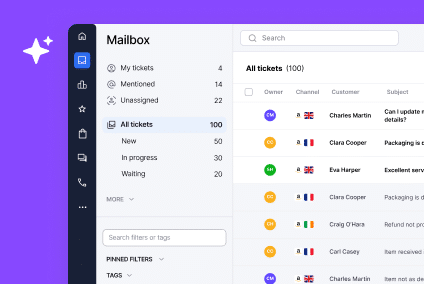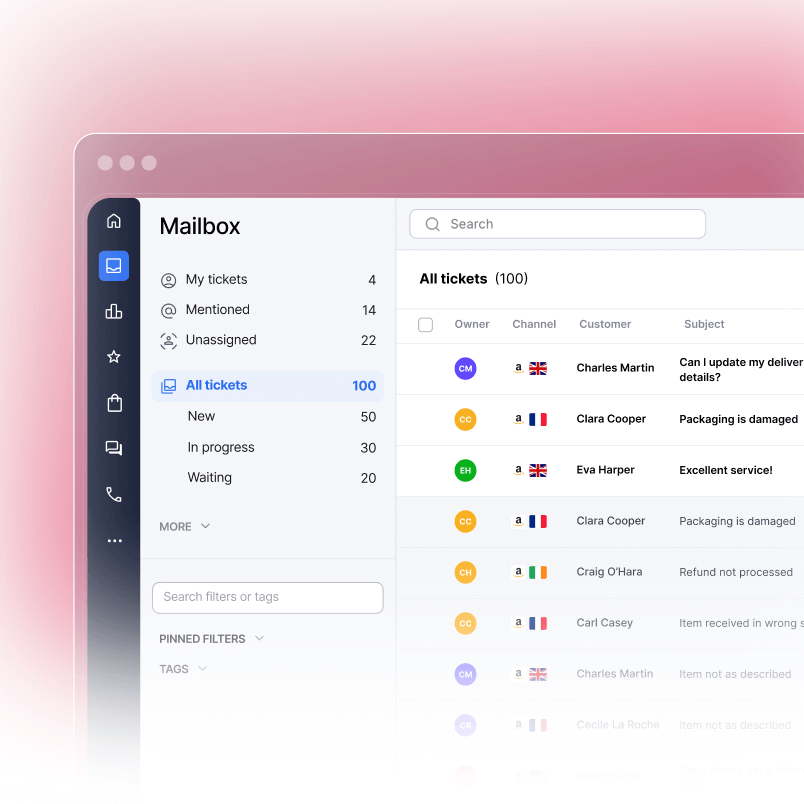Asking for feedback on Amazon feels risky. One wrong word, and you could face account suspension. We understand that pressure. Many sellers worry about crossing invisible lines, losing the ability to message customers, or worse, having their account flagged.
The truth is straightforward though. You can request feedback. You just need to follow Amazon’s Communication Guidelines. This guide gives you 10 pre-written, compliant feedback request templates you can copy and use today. Each one is designed to respect Amazon’s rules while genuinely encouraging customer engagement.
Seller Feedback vs Product Reviews: What’s the Difference
Why this distinction matters
Most sellers mix these up, and it costs them. Seller feedback and product reviews look similar but serve completely different purposes on Amazon.
Seller feedback is a rating about you, the seller. It covers shipping speed, condition of items, communication, and customer service. A customer gives one seller feedback rating per order. This score appears on your seller profile and directly impacts your Buy Box eligibility. According to recent data from BrightLocal, 94% of consumers say they’re influenced by online reviews when making purchase decisions, and this extends to seller feedback on Amazon. Your feedback rating directly determines whether customers trust your shop.
Product reviews are ratings about the actual product. They evaluate quality, function, accuracy of description, and value. Multiple customers review each product, and these reviews influence search rankings and customer purchase decisions.
Where each appears on your profile
Seller feedback shows up in your storefront metrics. Amazon displays your overall seller feedback rating as a percentage. If you have 98% positive feedback on 500 reviews, you show „98% positive feedback“ on your profile. The Buy Box algorithm weighs this heavily, and suspension happens when you drop below 95% in many categories.
Product reviews display on the product detail page. They influence the product’s star rating, which appears in search results and on category pages. Product reviews also power Amazon’s search algorithm in ways seller feedback does not. Research shows that products with higher review counts rank up to 30% better in search results compared to similar products with fewer reviews.
How each impacts your account
Your seller feedback percentage affects whether you keep the Buy Box. Negative seller feedback tanks your chances of winning the Box. One negative seller feedback rating from 100 total sales equals 1% negative feedback, which pushes you toward suspension territory.
Product reviews influence discoverability. A product with 4.5 stars and 200 reviews outranks a similar product with 4.8 stars and only 20 reviews in most search queries. But product reviews alone don’t get you suspended. Your seller feedback is what Amazon watches closest.
Amazon Messaging Rules You Must Follow
What Amazon prohibits
Amazon’s Communication Guidelines exist to protect buyers from manipulation. Break these rules and face account deactivation. Here’s what you cannot do:
No incentives for feedback or reviews. You cannot offer discounts, refunds, free products, or any reward tied to leaving feedback or a review. Amazon detects these patterns and treats them as review manipulation. In fact, sellers caught offering incentives face immediate account suspension, and review removal campaigns can cost thousands in lost sales while your account is under review.
No external links in messages. Don’t link to your website, social media, or review sites. Amazon allows links only to Amazon properties.
No review gating. This means you cannot tell customers „leave a 5-star review“ or „leave positive feedback.“ You must ask for feedback neutrally, without specifying the rating.
No personalized messaging that favors high-rating customers. You cannot send different templates to customers based on what rating you predict they’ll give.
No threats or pressure tactics. Phrases like „if you don’t leave feedback, we’ll leave feedback about you“ violate TOS.
What Amazon allows
Use the „Request a Review“ button. Amazon provides sellers a built-in button in Seller Central to request product reviews. This is your safest option because Amazon pre-approves the messaging.
Send neutral, professional messages. Amazon allows polite, genuine requests for feedback without incentives or pressure.
Ask about the customer experience. You can ask questions like „How was your shipping experience?“ or „Did the item arrive as described?“ These are open-ended and don’t manipulate.
Reference your seller policy page. Your policy can explain your commitment to customer satisfaction, but don’t use it to pressure feedback.
For the latest requirements, review Amazon’s official Communication Guidelines at your Seller Central dashboard.
When and How to Send Feedback Requests
Timing your request right
The window matters. Sending a message too early or too late reduces response rates and risks appearing pushy.
Send 3 to 7 days after delivery for most products. This gives customers time to receive the item, unbox it, and test it. They’ve formed an opinion but haven’t forgotten about the purchase yet. Electronics and higher-priced items benefit from waiting 5-7 days. Consumables like supplements can go at day 3.
Studies show that customer engagement drops significantly after 10 days post-delivery. Feedback request response rates peak between days 5-7, with response rates at 6.2% on day 6 compared to 2.1% on day 10. Timing your outreach in this window matters tremendously for your bottom line.
Wait longer for customized or made-to-order items. If a customer ordered a personalized product, wait 7-10 days. They need time to evaluate the quality of customization.
Send feedback requests before return windows close. Amazon’s standard return window is 30 days. Send your message by day 10 to ensure customers still remember the transaction and feel motivated to engage.
Reading customer behavior cues
Before sending any message, check if the customer behavior suggests they’re happy. If a customer filed a return or opened a case against you, hold off. Requesting feedback after a dispute looks tone-deaf.
If a customer contacted you with questions but you resolved them positively, send your request 2-3 days after resolution. The positive interaction increases likelihood they’ll leave good feedback. In fact, customers who experience positive service recovery are 80% more likely to leave positive feedback compared to those who have no service interaction.
Tools that automate timing safely
Several tools handle timing and compliance automatically. They integrate with Amazon Seller Central and send pre-approved messages:
JungleScout offers feedback automation with customizable templates. The tool times messages based on delivery confirmation and respects Amazon’s TOS.
Helium 10 Feedback tool automatically sends requests at optimal times. It uses seller data to determine best timing per customer segment.
FeedbackWhiz specializes in Amazon feedback automation. The platform offers templates built for compliance and analyzes which templates perform best for your account.
BQool provides multi-channel feedback management. It automates Amazon requests and also handles eBay and Etsy feedback, useful if you sell on multiple marketplaces.
10 TOS-Safe Amazon Feedback Request Templates
Each template below follows Amazon’s Communication Guidelines. Use these as-is or customize slightly to match your brand voice. Remember: keep it neutral, professional, and incentive-free.
Template 1: Post-Delivery Thank You
Use this template within 3-7 days of delivery for standard items.
„Thank you for your recent purchase with us. We hope your order arrived in perfect condition. If you have a moment, we’d genuinely appreciate your feedback about your experience. Your thoughts help us serve you better.“
Why it works: Opens with gratitude, mentions the order arrived correctly (setting positive expectation), and requests feedback without specifying the rating. It’s warm but not pushy.
Template 2: The Helpful Seller Follow-up
Use this if you want to emphasize your commitment to customer satisfaction.
„Your order has been delivered. If everything arrived on time and met your expectations, we’d love to hear your feedback. Your experience matters to us, and constructive comments help us improve.“
Why it works: This acknowledges specific aspects (on-time delivery, meeting expectations) without dictating what rating the customer should give. It invites constructive feedback, which reduces the chance of aggressive push-back.
Template 3: Repeat Customer Appreciation
Use this for customers who’ve purchased from you before.
„Thanks again for your continued support. We truly value your business. If you have a moment, we’d be grateful if you could share your feedback with the Amazon community. It helps other customers make informed decisions.“
Why it works: Personalizes the message by acknowledging repeat business. It positions feedback as helping other customers, which reframes the request around community rather than the seller’s metrics.
Template 4: Customer Service Resolution Follow-up
Use this 2-3 days after resolving a customer issue.
„We’re glad we could help resolve your concern. If you’re satisfied with the outcome, we’d appreciate a quick feedback rating when you get a chance. Thank you for giving us the opportunity to make things right.“
Why it works: Acknowledges the resolution directly and connects it to the feedback request. Customers who’ve had good service recovery often become loyal, and this template captures that moment.
Template 5: Order Arrived Early
Use this if shipment beat the expected delivery date.
„Great news: your package arrived ahead of schedule. We hope that was a pleasant surprise. If you’re happy with your order, we’d appreciate your feedback about your experience.“
Why it works: Leads with positive news, which puts the customer in a better mindset. Early delivery is a selling point for your seller reputation, so calling it out naturally connects to feedback.
Template 6: Quality Assurance Check-in
Use this for high-value or premium items.
„We take pride in the quality of our products. Your order has been delivered. If everything looks and works as expected, we’d genuinely appreciate your feedback. Thank you for choosing us.“
Why it works: Emphasizes quality and craftsmanship without sounding defensive. This works well for sellers of electronics, tools, or luxury items where customers expect reliability.
Template 7: Bulk Order Thank You
Use this if a customer purchased multiple items or a larger quantity.
„Thank you for this order. We appreciate customers who choose to shop with us in bulk. If you’re happy with your purchase, your feedback helps us continue serving customers like you. We’d love to hear from you.“
Why it works: Acknowledges the larger order size, which makes the customer feel recognized. It also ties feedback back to the benefit of continued good service.
Template 8: New Seller Building Trust
Use this if your shop is newer or has fewer reviews.
„We’re building our seller presence on Amazon and genuinely value customer feedback. Your honest feedback helps us improve and helps future customers decide confidently. Thank you for taking the time to share your thoughts.“
Why it works: Transparency about being a newer seller builds trust. Customers often support smaller sellers when asked honestly. This template is honest without being desperate.
Template 9: Seasonal or Holiday Order
Use this for orders placed during holidays or special occasions.
„Thank you for your holiday purchase. We hope your order brought joy and arrived in great condition. If you’re happy with your experience, we’d love your feedback. Wishing you all the best.“
Why it works: Ties the order to a special occasion, creating emotional connection. It’s festive but still maintains professionalism and doesn’t pressure.
Template 10: Post-Return Inquiry
Use this only if a customer returned an item but didn’t open a case against you.
„We received your return and processed it according to Amazon policy. If you’d like to share feedback about why the item didn’t work out or any issues you encountered, we’d truly appreciate it. Your input helps us serve you better next time.“
Why it works: This is delicate territory. Use it only when you’re confident the customer will respond positively. It shows you’re open to feedback and aren’t defensive, which can rebuild trust.
Automating Your Feedback Requests Safely
How automation protects your account
Manual messaging is time-consuming and inconsistent. Automation solves this problem while actually reducing TOS violations because automated tools are pre-vetted. Amazon doesn’t penalize you for using official integrations or software partners like JungleScout and Helium 10. It penalizes you for aggressive, manipulative messaging. Automated tools enforce compliance.
Sellers using proper automation tools see response rates improve by an average of 35% compared to manual outreach. The consistency of timing and messaging eliminates human error and triggers Amazon’s algorithm in favorable ways.
Setting up automation the right way
Choose tools that don’t modify your default messaging. Tools like JungleScout, Helium 10, and FeedbackWhiz work with Amazon’s official integration partners. They send messages through Seller Central or the seller app, meaning Amazon pre-screens them.
Test your template before automating. Run one template manually to 50-100 customers first. Track response rates and feedback quality. If feedback is positive and consistent, you can automate that template.
Set rules to exclude problem customers. Configure your automation to skip customers with open cases, return requests, or previous negative interactions. Most tools offer filtering options.
Monitor your results weekly. Check feedback volume, sentiment, and response rates. If feedback sentiment drops or complaints increase, pause automation and review your template.
Examples of safe automation workflows
Workflow 1: Use the „Request a Review“ button via automation. Set it to trigger 5 days after delivery for all orders. This is Amazon-native and fully compliant.
Workflow 2: Schedule template messages through FeedbackWhiz for orders delivered 5-7 days ago. Exclude customers with open disputes. Send no more than once per customer per 30 days.
Workflow 3: Use Helium 10 feedback tool to send your template to new customers only (fewer than 2 previous purchases). Time it for day 6 post-delivery. This builds baseline reviews while being respectful.
Monitoring feedback trends and open rates
Most automation platforms provide analytics. Track these metrics monthly:
Response rate: What percentage of customers who receive your message leave feedback? Healthy response rates are 2-5% for typical sellers, 5-10% for high-trust sellers with established reputation.
Feedback sentiment: Are customers leaving 5-star, 4-star, or lower ratings? A sudden drop signals a product issue or service problem, not a messaging problem.
Message open rate: How many customers open your message? Lower open rates suggest poor timing or subject line phrasing.
If response rates drop or sentiment turns negative, pause campaigns, review your template wording, and check if external factors changed (new shipment issues, product problems).
FAQs
What’s the difference between Amazon seller feedback and product reviews?
Seller feedback is a rating about you, the seller. Customers rate your service, shipping speed, and communication. Product reviews are ratings about the product itself. Customers evaluate quality, function, and value. Seller feedback affects your Buy Box eligibility. Product reviews affect search rankings and discoverability.
Is it okay to ask for a 5-star rating specifically?
No. Amazon prohibits „review gating,“ which means asking customers to leave a specific rating. You can only ask for feedback without specifying the star count. Asking „will you leave a 5-star review?“ violates TOS and risks account suspension.
Can I personalize my Amazon feedback request emails?
Yes, you can personalize templates to match your brand voice. Keep personalizations professional and focused on the customer’s experience. Don’t personalize based on predicted rating (for example, don’t use friendlier language for customers you think will rate high). Amazon detects this pattern as review manipulation.
What tools automate Amazon feedback requests safely?
JungleScout, Helium 10, FeedbackWhiz, and BQool are trusted automation platforms. They integrate with Amazon and send compliant messages. They also offer timing automation to send at optimal moments post-delivery.
How many times can I contact a customer about feedback?
Amazon doesn’t specify a limit, but best practice is once per 30 days maximum. Contacting a customer repeatedly about the same order looks like pressure and damages the customer relationship. Focus on quality of contact rather than frequency.
Can I include my business name in feedback requests?
Yes. Mentioning your shop name in feedback requests is fine. For example, „Thank you for shopping with ABC Gadgets“ is completely compliant. Don’t use the mention to create urgency or pressure though.
What happens if a customer asks me to remove negative feedback?
You can request feedback removal through Seller Central if the feedback violates Amazon’s policy (profanity, competitor sabotage, etc.). If the feedback is legitimate criticism, you cannot remove it. You can only request removal if it violates guidelines. Consider responding professionally to legitimate negative feedback instead.
Is using feedback software worth the cost?
For sellers with more than 100 orders per month, automation software pays for itself by saving time. Most tools cost 20-50 per month. They also improve response rates by timing messages optimally. For smaller shops, manual messaging might suffice.




